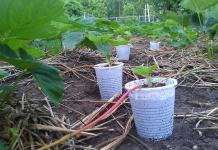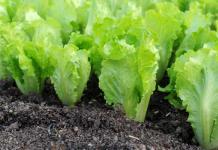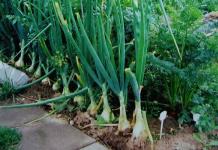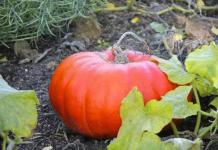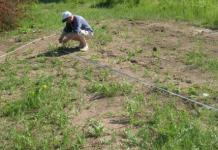" Onion
The combination of crops that successfully complement each other on the same bed allows you to get a healthy harvest. Onions will drive away pests, carrots, in turn, thanks to the tops, will create a shadow. Plants will not harm each other in any way. In addition, an unusual planting will add originality to the garden.
The roots of the bulbs are much higher than the rhizomes of carrots, so the plants coexist perfectly on the same bed. This method is used to increase the productivity of the garden..
Due to the mixed planting, the rows are compacted - this allows you to collect rich crops in small areas.
Carrots occupy the garden area for almost the entire season. Seeds are planted at a distance, and bulbs are favorably placed in the aisles.
Thanks to the onion crop is harvested earlier, the roots of carrots are gaining growth until autumn and get additional loosening of the soil.
Carrots grown in this way along with onions grow larger and juicier. It does not interfere with the ripening of the bulbs.
By the time the tops grow, arrows form on the bulbs, later they dry out and fall to the ground.
If you follow all the rules of planting, there will be enough space in the garden for the growth of large-sized crops.

Compatible varieties for planting
There are no fundamental rules for choosing a variety. Gardeners manage to plant and grow root crops with onions and sevka.
Only, what should be observed if it is planned to plant large bulbs- spacing between rows.
Traditionally, 15-20 cm are left between rows, if large onion varieties are planted, the distance should be increased to 30 cm.
For those who fear that the carrots will not have time to ripen and thicken, it is recommended early ripe varieties - Ural or May.

Seed preparation
To harden them during early planting in the spring, seeds can be placed in the refrigerator for a day.
If planting is supposed to be in the middle of spring in a dry climate, seeds are soaked so that they hatch faster.
For this purpose, the seeds are placed in a wet cloth, tied in a bag. The seeds are kept for 7 days, periodically they need to be moistened with water.
During this time, the seed will hatch, seedlings will appear much earlier. This method is not suitable for cold climates and during frost periods.
To make the onion rise earlier, you can cut ponytails with scissors. In a stable warm climate, the bulbs can be soaked in a solution of potassium permanganate. This will allow the roots to awaken and disinfect the seed material from fungi.
Onion sets are laid in the ground, as is, or planted with seedlings. Seeds must not be cut. The shelf life of seeds is 2-3 years.

Garden preparation
Even unpretentious vegetable crops require prepared soil. It must be pre-loosened and fertilized.
This can be achieved with the help of simple rules for preparing the soil for planting:
- The soil that has been dug up and fertilized with organic matter since autumn, in spring, is sprouted.
- Mark the boundaries between rows for sowing. This can be done using a rope stretched over the entire length of the bed.
- A groove is made into which ash and sawdust are laid. Seedlings are sown on top.
- The next furrow is being prepared for carrots. It can be sown or lay seeds glued to paper.
- Rows alternate at their discretion. When everything is planted, the grooves are carefully sprinkled with earth. You don't need to trample them.
- Water regularly when shoots appear. Do not let the soil dry out.
- If planting is carried out in early spring, the rows need to be insulated with covering material.
This way of landing is very convenient., eliminates frequent weeding and does not require protection from pests.

How to plant: scheme
Desperate gardeners are not afraid of experiments. It is thanks to them that original ways of growing vegetable crops in mixed beds appear. The main thing is to keep the right neighborhood, not every culture gets along with each other.
As for root crops and onions, they are very successful neighbors.. There are many ways of planting, someone alternates rows, and someone gets good yields when they are sown together in one furrow.
The second option is preferred when planting carrots and onion sets. The most popular schemes for mixed beds:
- seeds are mixed with onion kernels and densely sown in furrows;
- seeds are glued to toilet paper and rolled out along the length of the beds;
- turnip onions are stuck into the soil with their hands, seeds are sown between the rows;
- onion seedlings are placed in holes made with a stick, neighboring furrows are sown with carrots.
By delimiting a bed of root crops with onions, you can get an even bed. Since carrots sprout later, it is preferable to plant bulbs around the edges. They are called "beacons".
Any of the presented planting options is suitable for any suburban area.
For comparison, you can break different beds in the garden. This will allow you to understand which option is most optimal for certain conditions.
Planting carrots and onions according to natural farming:
Harvest time
Harvesting dates for carrots and onions are different. The bulbs ripen earlier, so they are harvested in July. Carrots of early varieties in August. Late varieties in September.
When harvesting onions, carrot rhizomes do not suffer, as they are located deep in the ground.
When the bulbs are collected, space will be freed up. All moisture will flow to the rhizomes of carrots.
Harvesting onions will help loosen the soil thus, it will be enriched with oxygen. Additionally, the soil can be fed with organic matter.
Some gardeners practice partial collection, not all the bulbs are plucked, but through one. They allow the onion to grow and remain in the soil until the onset of autumn. Accordingly, carrots can also be broken through in the process of growth.
The soil must be moist when harvesting. then you won't need to use a shovel. If the bed is loose, the ripe crop can simply be pulled out with your hands.

There are a lot of advantages of combined garden rows Firstly, it is a useful neighborhood. Secondly, it saves space. Thirdly, the aesthetic appeal of the garden.
Between plants located nearby, there is a certain interaction. Some of them are true friends who are ready to help each other in every possible way, the second are neutral, and the third tend to be at enmity with others. In order to use this influence to get a decent harvest and avoid annoying mistakes when planning a garden, it is necessary to understand which crops can be planted side by side, and which vegetables in the beds are extremely undesirable.
What is mixed landings
If the garden area is small, but you want to get a variety of fruits, but more, circumstances suggest a way out: compacted crops or mixed plantings. This is a method of organic farming, when several different crops are cultivated in the garden at the same time: vegetables, herbs, berries, flowers, planted, taking into account the compatibility of plants, mixed or according to a certain pattern.
Mixed landings: benefits and beauty
The question is natural: is the topic of combined plantings relevant for owners of spacious plots? Each gardener, intending to populate his site with “green friends” in the spring, wants to get the most out of each garden. At the same time, any experienced vegetable grower knows that fertile land, high-quality seeds, healthy seedlings, the use of effective fertilizers, and competent care for plantings in the neighborhood are necessary to obtain a significant harvest.
However, few people take into account another significant circumstance: allelopathy. Don't let this scientific name of the phenomenon of biochemical influence of some cultures on others or their mutual influence scare you. Allelopathy is able to provide mutually beneficial conditions for the coexistence of vegetables adjacent to the garden during joint plantings, but it can also serve as a factor that suppresses the development of individual species.

Good Neighborhood
The essence of the effect is that all parts of plants release into the environment (air, soil) biologically active substances - phytoncides, antibiotics and others. These compounds, depending on the species, can either be absorbed and act beneficially on crops located in the neighborhood, or oppress fellows in the garden. The successful selection of green "cohabitants" allows you to harvest more from the garden, grow healthy, beautiful fruits with improved taste.
In addition to the positive manifestation of allelopathy, there are still many profits that encourage the organization of joint plantings on the site, even if there is enough space for separate cultivation.

isolated neighborhood
Benefits of mixed landings
It is worth noting that the combination of vegetables in the garden is not the latest trend in garden agricultural technology. Since ancient times, the American Indians have known a successful trio: peas, corn, pumpkin. The classic community of plants has successfully migrated to our days and is successfully used by many vegetable growers: peas enrich the soil with nitrogen, corn serves as its support, pumpkin, covering the ground, fights weeds.

Classic trio
The organization of joint plantings is a more promising and exciting activity than the cultivation of monocultures on separate sites. However, the approach to planning "communal" beds must be responsible. It is not enough to know what vegetables and other crops can be planted nearby, you need to be prepared for observations, analysis of the results of the neighborhood. But people who have decided to experiment and have already harvested more than one crop from combined plantings note the many advantages of this approach:
- The available land area is used more rationally, the crop is removed from it more than when planting with a monoculture.
- Vegetables in the garden have a good appearance, are healthy or get sick less.
- The need for crops for watering is reduced.
- There is no need for frequent thorough weeding of beds.
- Reduced time for preparatory garden work.
- It becomes possible to reduce or eliminate the use of mineral fertilizers, due to nitrogen fixation by legumes.
- One-sided depletion of the soil, its "fatigue" is prevented, the need for crop rotation gradually disappears.
- Avoiding pesticides is becoming a reality, as many plants attract beneficial insects and pest-killing birds. There are also flowers and herbs that repel harmful insects and rodents.
- The harvest is carried out throughout the season, if other crops are sown on the area vacated after the early ones.
- It is possible to create a kind of microclimate in the garden, using tall, stable plants as wings to protect gentle neighbors from winds and direct sun.

Cabbage, marigolds, calendula - a wonderful neighborhood
Rules for the formation of combined landings
The experience and observations accumulated by gardeners show that, in addition to the listed advantages, mixed cultivation even affects the taste of vegetables. In particular, such herbs as basil, celery, monarda, parsley, improve the taste of tomatoes. Bush beans can make radishes more savory. A cucumber planted next to a sunflower will please you with especially sweet, crisp greens.

These tomatoes are especially delicious.
Choosing the right combination of vegetables among themselves in the garden and realizing all the advantages of growing plants in a mixed type is possible only if certain rules are observed. When planning the organization of a "communal" garden bed, it is necessary:
- Consider the climate in the region.
- To study the specific features of your own site and focus on them: a garden in the sun or in shading, is it protected from the winds, what are the agrotechnical characteristics of the soil, is there a possibility of watering.
- Orient the beds in such a way that tall specimens do not shade light-loving neighbors and, on the contrary, shade those for whom the hot sun is harmful.
- Combine plants with different growing seasons. Early vegetables, greens (onions, radishes, Chinese cabbage, lettuce) in mixed plantings should be planted with crops with a long ripening period (cucumbers, zucchini, eggplant, beets, tomatoes).
- Decide whether there will be enough food area for all the "residents" of the garden. It depends on the development of their root system. Plants with deep, powerful roots should be placed next to crops with a shallow root system.

Scheme of a small garden bed with combined plantings
As a rule, three crops are grown in a mixed bed: the previous early crop, the main one, and the partner plant. With sufficient knowledge and experience in gardening, you will draw up schemes for combined plantings on your own. If you do not rely on your experience, use ready-made landing patterns, special tables from the examples below.

Compatibility table
Compatibility of crops on the same bed
Now we should dwell on the compatibility of some common crops with other plants in the common garden and figure out which neighborhood is beneficial for them, which is acceptable, and which is harmful.
Bow and the best neighbors for him
It is difficult to imagine the diet of a Russian without onions, every summer resident hopes to prepare it for the whole winter. It is interesting to find out how he behaves in a mixed garden, whether he makes the neighbors “cry”.
It is reliably known that onions are not only useful for humans - they are an excellent companion for many other crops, diligently protecting them from diseases and pests. Thanks to this, plants placed nearby develop well and give an increased yield. But the gardener, aimed at getting a solid harvest, is also interested in what kind of neighborhood is favorable for the onion itself.
We can immediately say that this vegetable will be comfortable in the company of salads, radishes, tomatoes, parsley, beets, cucumbers, strawberries. And from grapes, legumes, sage, you should keep it away.

Comfortable neighborhood
Many vegetable growers who master the technique of joint cultivation of vegetables are concerned with the question of whether it is possible to plant onions and garlic on the same bed, because they are so similar: they have the same sowing dates, requirements for soil, lighting, and agricultural technology. However, these cultures are from a common family - their similarity is also manifested in the presence of common pests, diseases, from which they cannot protect each other.
In onions and garlic, the root system is located superficially, which means that they can compete in terms of nutrition and moisture. There are more minuses in such a neighborhood than pluses, and it is not worth planting them mixed in a small area. In extreme cases, you can divide the "living space" between them in half. But the best option would be to plant onions and carrots on the same bed - this combination has become a classic in the practice of co-growing vegetables.

Carrots and onions are friendly
Carrots and the ideal growing environment
Carrots and onions are the perfect duo. They do not just coexist peacefully - their position is active in relation to each other's pests. Carrots will safely scare off the onion fly, and the carrot fly will not even approach the zone where the onion defender stands side by side with the tasty root crop. The simplest example of such a bed: the central row of onions along its length and two rows of carrots on the sides.

classic neighborhood
However, it is worth noting that these crops have different requirements for watering. When the bulbs are full and begin to ripen, the onion does not need water, it is even harmful to it, and at this time only give carrots a drink. If the climate in the region is such that vegetables cannot be grown without watering, one has to either leave onions only as a protector, or say goodbye to part of the carrot crop, trying to protect ripening onions from rot.
The way out of the described situation can be the cultivation together with carrots of perennial onions or onions for greens. Or you should find out what else can be planted on the same bed with carrots, and implement the idea. Having studied the above plate, you can make sure that carrots are good next to radishes, peas, lettuce, tomatoes, spinach, garlic. Its proximity to parsley, celery, dill is undesirable.

Carrots are comfortable next to radishes
By the way, many are surprised that the openwork sprigs of self-sowing dill should be removed from the garden with carrots. But everything is natural: these plants from the same family compete for water and food. In addition, both of them (like all umbrella ones) are attractive to the carrot fly. Therefore, leaving pretty dill bushes among carrot crops is undesirable. Moreover, it is unacceptable to deliberately plant carrots and dill in the same garden - this is an unfortunate neighborhood.

The result of an unsuccessful neighborhood
Garlic and other plants in the same garden
Garlic is a wonderful plant that endows the space around it with healthy phytoncides. It is a natural fungicide that is excellent in the fight against fungal infections. This quality is to the liking of most of garlic's neighbors: in its environment, potatoes can cope with late blight, carrots and psyllids will not be damaged by carrots, and strawberries will not be attacked by harmful insects.

Garlic is a natural healer
So you can plant a lot of vegetables, herbs, flowers next to garlic in the garden. He likes carrots, cucumbers, radishes, lettuce, beets, tomatoes, and celery especially favors him. And for the garlic itself, they are the best neighbors. Many flowers feel great in the presence of a fragrant vegetable. Of those with whom garlic is especially friendly in the garden, one can name roses and bulbous flowers: tulips, gladioli, daffodils.

Good garlic partners
Despite its beneficial properties, the neighborhood of garlic is contraindicated for peas, lentils, beans, peanuts. They can not be placed not only on the same bed, but also in the vicinity of a site planted with garlic, which has such an adverse effect on legumes that they cease to develop normally and almost do not bear fruit. It is unacceptable to plant cabbage and perennial onions next to it. But for raspberries, strawberries, garlic will be the best companion.

For tulips, the neighborhood with garlic is beneficial
Strawberries and Suitable Neighbors
When setting up a strawberry plantation, summer residents often think about what can be planted next to strawberries in the same garden to protect the berry from pests and diseases. Inquisitive farmers have found a solution: a healer from nature, garlic, does an excellent job with this task. He is afraid of such pests:
- ants;
- strawberry weevil;
- nematodes;
- wireworm;
- spider mite.

Garden strawberry (in everyday life - strawberry)
The glorious defender of the sweet berry is planted in a row between the rows of strawberry beds and between holes with berry bushes. Strawberries (garden strawberries) reciprocate garlic: the heads of garlic grow even larger and stronger than when planting it on a separate “living space”. Everyone who practices growing strawberries and garlic in the same garden is sure that their neighborhood is very beneficial.

bittersweet couple
Beans, onions, eggplants, radishes, spinach, and parsley can also be considered good companions for fragrant berries. The latter drives away slugs from ripening berries. But there are no cultures with which strawberries would have poor compatibility: apparently, they are very friendly to their neighbors and are loved by all of them.

The best neighbor of strawberries is beans
It is known that different varieties of individual crops (for example, potatoes) can be at enmity, not only when planted side by side, but even during storage of the crop. Therefore, disputes are not uncommon between garden owners on the topic: is it possible to plant different varieties of strawberries on the same bed or this will lead to civil strife or cross-pollination. There is no reason to be afraid of one or the other: the bushes of garden strawberries simply do not know how to quarrel.
Cross-pollination occurs, but it will affect the type and quality of berries only if strawberries are propagated by seeds. With vegetative propagation, the variety will not be disturbed - the main thing is not to confuse which mother plant the rosette is separated from. For these reasons, it is worth planting varieties of garden strawberries, if on the same bed, then in separate groups.

Parsley keeps slugs away
Cucumbers in joint plantings
Pimply crunchy greens - what could be better at the beginning of summer? And if you are already set on the joint cultivation of vegetables, you should know which cucumber neighbor in the garden will be their faithful assistant, and which one will oppress. Cucumbers are picky, a good neighborhood is not a problem for them - in this regard, they are compatible with most vegetable crops. It is easier to list those plants with which cucumbers do not develop relationships.

Corn curtains protect from the wind
The list is short:
- potato,
- radish (here the opinions of experts differ),
- tomatoes (debatable)
- spices.

Dill is a wonderful partner of cucumbers
Much more than the neighborhood, the development of this vegetable is influenced by the microclimate and soil. Therefore, when deciding what to plant in a garden with cucumbers, more attention should be paid to the ability of companions to protect growing vines from the aggressive effects of the environment. For example, backstage of corn will be an excellent protection for cucumber lashes from the winds, and beans will supply them with nitrogen. Among herbs, there is one exception: dill goes well with cucumbers.

Another example of a pleasant neighborhood
Beets on the common garden
When deciding what to plant beets with, you should be guided by scientific data and be guided by common sense. The German scientist Hubmann, who studied plant compatibility for many years, concluded that plants such as beets, potatoes, tomatoes, bush beans, spinach can coexist perfectly, stimulating each other. Good neighbors for beets, in his opinion, are also onions, kohlrabi, lettuce, garlic, strawberries.

Commonwealth of root crops
As for the incompatibility of beets with other vegetables, there is no consensus. Some vegetable growers, in contrast to Hubmann, argue that this root crop does not grow well next to potatoes. However, many gardeners successfully grow it along the edge of potato ridges. Neither scientists nor practitioners have decided on the usefulness or harmfulness of the neighborhood of beets with corn, chard, chives.
There is a version that the substances secreted by beet roots have antibiotic properties and have a healing effect on neighboring plants. Therefore, growing, for example, beets and carrots on the same bed will have a positive effect on both crops.

Joint cultivation of beets, onions, carrots
True, care will need to be taken to maintain a sufficient interval between rows, bearing in mind that powerful beet foliage can greatly obscure companions. A good option for mixed growing vegetables would be a bed with a row of onions planted in the center, a row of beets and a row of carrots along the edges.
Pumpkin in the neighborhood with other cultures
Pumpkin does not experience special preferences and hostility towards vegetables growing nearby. However, the proximity to the previously mentioned corn, peas, as well as other legumes, radishes, and nasturtium can be called quite successful for her. Sometimes gardeners, trying to maximize the area of the compost heap, plant zucchini on it together with pumpkin.

Friendship is friendship, but the beds are better apart
But pumpkins and zucchini cannot be good neighbors in the same garden. As a result of cross-pollination, fruits of a shape and color unusual for both vegetables grow. Hybrids on zucchini grow round, and oblong on pumpkins. Their taste is also affected. This is a vivid example of the unsuccessful application of the mixed growing system, and it is not worth venturing into such an experiment.

Such a company is better for a pumpkin
Tomatoes surrounded by neighbors
Some consider tomatoes to be as individualistic as pumpkins. But, if we turn to the experience of Swiss, German and domestic gardeners, it is easy to see that the cultivation of tomatoes in the vicinity of other crops is quite realistic. They go well with radishes, lettuce, carrots, celery, parsley, beets, garlic. There is no doubt that these vegetables and herbs can be planted on the same bed with tomatoes.
Their mutual influence can be different. For example, the commonwealth of garlic and tomatoes is favorable for the latter: garlic protects them from spider mites and reduces the risk of late blight. And the best companion of tomatoes is basil, which not only promotes the growth of the vegetable, but also improves its taste. By the way, other aromatic herbs have the same property: borage, lemon balm, marigolds, mint.
The effect of nettle growing nearby is interesting: it increases the shelf life of tomatoes and improves the quality of tomato juice. As a rule, those who grow tomatoes and carrots on the same bed, the line of which is placed along a row of tomatoes, are satisfied with the results. But tomatoes have almost no enemies - only fennel can be attributed to obvious antagonists, which is such in relation to almost all vegetables.

Neighborhood eggplant pepper in joy
Bell peppers in the center of a mixed vegetable garden
It is impossible not to mention the possible neighbors of bell pepper in the garden. He has a good relationship with basil, eggplant, dill, spinach, thyme. Marigolds, coriander, onions, with which he gets along well, can act as defenders of pepper from aphids. And a plant like okra can be planted next to fragile pepper bushes to shelter them from the wind.
The company of tomatoes, peas, cabbage, beets, beans, carrots is contraindicated for pepper. It is highly undesirable and the neighborhood of a sibling - hot pepper. It will not interfere with the development and fruiting of the "Bulgarian", but the result of cross-pollination will be the loss of the crop, since sweet peppers can no longer be called such. You can decide what to plant next to pepper on the same bed, focusing on the lists of successful and unsuccessful neighbors.
Cabbage as the best neighbor for vegetables and herbs
There are many types of cabbage, they grow and bear fruit in different ways. But they have common problems with pests and diseases, so the problem with which cabbage can be planted in one garden is solved for all varieties in almost the same way. An excellent partner for cabbage is celery, gaining additional flavor and being stimulated to grow by the influence of cabbage. In turn, he drives away white butterflies and cruciferous fleas from the beds.
Neighborhood is useful for cabbage:
- different types of onions
- lettuce,
- potato,
- aromatic herbs (sage, dill, chamomile),
- beans,
- garlic.

Pleasant Cabbage Neighbors
Cabbage and tomatoes do not get along on the same bed. Strawberries are also not in favor with the "garden lady". But cabbage cabbage is still different. By placing cauliflower next to a white-headed sister, you can miss the calculation for the yield of colored heads: their tying in the vicinity of a white-headed beauty is significantly reduced.
Potatoes and useful crops for it
Growing "second bread" in a mixed culture is beneficial: it gets sick less, does not need crop rotation so much. Beans and spinach are good as potato neighbors in the garden. A remarkable result can be obtained if you plant bush beans in the aisles of potatoes - it repels the malicious pest, the Colorado potato beetle, enriches the soil with nitrogen. The malevolent beetle is also repelled by tansy, marigolds, coriander, and nasturtium.

Potatoes and beans in the garden
Potatoes also feel good in the company of radishes, corn, varieties of cabbage, salads. Favorable for him is the company of horseradish planted in the corners of a potato field, but the proximity of sunflower and quinoa is depressing. The combination of potatoes with celery is undesirable. Regarding the compatibility of potatoes and beets, peas and tomatoes, opinions are contradictory.
You have gained some insight into the benefits of co-planting garden crops. If you are fascinated by this idea, do not stop: study the characteristics of those plants that you plan to cultivate, consult experienced gardeners, consult specialists, and success will certainly come. Your favorite garden, sparkling with new colors, will delight you with its appearance and worthy harvests.
 The special arrangement of nature has always surprised man. It is so arranged in it that nearby plants help each other or, on the contrary, start a “struggle” for a place in the sun. If you are seriously convinced that the danger to the garden lies solely in the weeds, then you are mistaken! Nearby beds with incompatible crops can cause a gardener to be in a bad mood.
The special arrangement of nature has always surprised man. It is so arranged in it that nearby plants help each other or, on the contrary, start a “struggle” for a place in the sun. If you are seriously convinced that the danger to the garden lies solely in the weeds, then you are mistaken! Nearby beds with incompatible crops can cause a gardener to be in a bad mood.
So, what should not be planted close to each other? For example, it is not recommended to grow cucumbers next to lettuce, as these vegetables will not be able to live "in harmony" with many herbs, including aromatic ones. Dill is no exception. As you can see, there are many nuances and subtleties in this matter. We will try to deal with them in this article when we give an answer to the question - what to plant next to the carrot?
Carrots are a vegetable that every hostess always needs! All year round they add it to all sorts of dishes, both hot and raw. Salads with carrots are especially delicious. What neighborhood with carrots will be the most favorable?
Onions and carrots
 Onions and carrots are "eternal" cohabitants. Of course, you have already heard many stories about carrot flies, which liked this root crop no less than people. If you plant carrots and onions on the same bed, then this pest will be able to drive away. The reason is that such flies cannot tolerate the aroma of onions. The benefit of a nearby onion also lies in the fact that it prevents root mites from damaging carrots.
Onions and carrots are "eternal" cohabitants. Of course, you have already heard many stories about carrot flies, which liked this root crop no less than people. If you plant carrots and onions on the same bed, then this pest will be able to drive away. The reason is that such flies cannot tolerate the aroma of onions. The benefit of a nearby onion also lies in the fact that it prevents root mites from damaging carrots.
As they say, a carrot does not remain in debt. It protects the bow from onion flies and moths. It is worth noting that this root crop is an excellent cohabitant for all varieties of onions, and even for garlic.
There are separate methods for sowing onions and carrots. The essence of one of these methods is that it is necessary to scatter onion seeds in the garden fourteen days before the start of sowing carrots. It is not necessary to sprinkle the onion seeds immediately, but after the carrots are sown. This is not only convenient for the gardener - he does not have to do one job several times, but also useful, because crops will be sown at a time convenient for them.
The situation is different if you decide to plant carrots next to onion sets. First you need to plant carrots, and after a few weeks, start planting sevka. It is recommended that carrots and onions grow through a row or even two rows.
When planting carrots and onions together, be aware that the first crop is compatible with tomatoes, while they cannot be planted next to onions!
Carrot and celery

 It is not recommended to grow carrots and celery in the same garden. These cultures don't mix well with each other. Celery does not protect the onion from the onion fly, on the contrary, it attracts insects that are dangerous for it.
It is not recommended to grow carrots and celery in the same garden. These cultures don't mix well with each other. Celery does not protect the onion from the onion fly, on the contrary, it attracts insects that are dangerous for it.
Planting onions on the same bed with carrots has a number of features. These crops are recommended to be sown earlier than carrots. If you sow a vegetable ahead of schedule, then its sprouts may fall under spring frosts, and then instead of a rich harvest, you will get a "flower bed". It is known that carrots bloom only in the second year, and she can "decide" that he has already come and it's time for her to bloom.
A plus for crops in close proximity to carrots is that, when blooming, it attracts various beneficial insects with its aroma.

 Carrot is a vegetable that is present during the meal on almost every table. This root crop is rich in vitamins, trace elements and beneficial minerals. No wonder in Rus' they said that this vegetable brings strength to people. Not only useful properties, but a pleasant taste distinguish carrots. Even desserts are prepared with its use, and it is recommended to give young children delicious carrot juice.
Carrot is a vegetable that is present during the meal on almost every table. This root crop is rich in vitamins, trace elements and beneficial minerals. No wonder in Rus' they said that this vegetable brings strength to people. Not only useful properties, but a pleasant taste distinguish carrots. Even desserts are prepared with its use, and it is recommended to give young children delicious carrot juice.
But in order to get a good harvest of carrots, you need to know which crops are best placed next to them. The most optimal compatibility of carrots:
- Beans,
- Radish,
- Sage,
- Peas,
- Salad,
- Garlic.
What is incompatible with carrots?
 Carrots are a common root vegetable. It is grown in almost every garden, but not always the harvest is as good as the gardener would like. It would seem that there is no drought, and it was planted at the right time, and its care is excellent. What's wrong with carrots?
Carrots are a common root vegetable. It is grown in almost every garden, but not always the harvest is as good as the gardener would like. It would seem that there is no drought, and it was planted at the right time, and its care is excellent. What's wrong with carrots?
And the answer is not as complicated as it might seem. The disastrous neighborhood with other cultures is the main reason. The vegetable spends all its "strength" and "reserves" on the fight, and the carrot grows thin, weak and in small quantities.
The following crops are incompatible with carrots on the same bed:
- Anise,
- Beet,
- Horseradish,
- Parsley,
- Fragrant greens.
Moreover, carrots are recommended to be planted as far as possible from apple trees. Otherwise, you may end up with bitter vegetables, and bitter apples. Of course, I want to grow sweet carrots, so it is best to refuse such a neighborhood.
 Now you know what to plant next to carrots, and which crops should be avoided. The gardener must take this information seriously. Be sure that by planting carrots away from dill, you will get an excellent crop that your neighbors will envy! The main thing is the correct seating. Knowing which vegetables are in conflict with each other, you can protect them from losses, because in the first place it is beneficial for you! On the contrary, knowing which cultures are "friendly", help each other and protect against insects, you will deliberately plant them next to each other.
Now you know what to plant next to carrots, and which crops should be avoided. The gardener must take this information seriously. Be sure that by planting carrots away from dill, you will get an excellent crop that your neighbors will envy! The main thing is the correct seating. Knowing which vegetables are in conflict with each other, you can protect them from losses, because in the first place it is beneficial for you! On the contrary, knowing which cultures are "friendly", help each other and protect against insects, you will deliberately plant them next to each other.
This is such a unique nature! It is very difficult to grow a good crop of carrots and beets on the same bed, and for many summer residents it is almost impossible. Nearby beetroot and carrot beds can produce a quality crop with proper care.
Vegetable neighbors - video
Every advanced summer resident knows the importance of crop rotation in planting planning for the coming season. Some plants are helpers for each other, which saturate the soil with necessary substances and kill harmful organisms. Other groups of vegetables are contraindicated to each other. They deplete the soil and are carriers of the same diseases. If you know what to plant carrots next to, you can get an interesting mixed bed. The advantage of combined sowing is that the flavors of herbs and vegetables are mixed with each other, and pests cannot determine which vegetable is theirs.
Compatibility of carrots with other crops
| Compatible | Not compatible |
|---|---|
| Onion | Dill, anise, parsley and other Umbelliferae |
| Legumes (especially beans and peas) | apple trees |
| Garlic | Beet |
| Radish | Horseradish |
| Sage | Celery |
| Strawberry | |
| Salad | |
| Potato, tomato and other Solanaceae | |
| Zucchini | |
| Cucumbers (but only after 1-2 years) |
Knowing the compatibility of crops is necessary not only for combining plantings in the current season, but also for predicting a change in places. In crop rotation there is a rule of "tops" and "roots". If root crops are grown in the garden this season, then next year it is best to plan planting plants whose fruits ripen on branches. This is necessary so that the soil has time to recover and be replenished with nutrients.
To enrich the soil after carrots, it is recommended to plant strawberries and strawberries. But carrots feel good in the beds after potatoes and onions. Potatoes perfectly loosen the ground and make it soft, so carrots will develop very comfortably in such conditions. Onions enrich the soil with nitrogen and potassium, which is also beneficial for carrot crops, which need a lot of nutrients for development. Cucumbers are also on the list of favorable neighbors and predecessors of carrots, but you need to give the soil a little time for its composition to become optimal for carrots. Cucumbers oversaturate the soil with nutrients, which is not very good for carrots, it begins to experience difficulties in growth. The land, rested for a year or two after cucumbers, becomes optimal for sowing carrots.
How to plant carrot compatible crops
With a sufficient amount of knowledge and skills, combined plantings include 3 or more crops on one bed per season. At the initial stage, you need to master simple pair combinations.
How to plant carrots in one garden
Onion
When asked whether it is possible to plant onions next to carrots, any agronomist will answer positively. Onions and carrots are the most favorable neighborhood of all possible. These crops can be safely sown on the same bed, as they are each other's protectors from pests. Carrot flies are intolerant of onion flavors, while carrot esters repel onion flies. When planting onions with carrots in one area, it is worth considering some of the nuances:

Legumes
There is no consensus about this neighborhood, some gardeners claim that legumes are ruining carrots. Most often, peas and beans are recognized as neighbors of carrots for a good harvest, since carrots grow very large and juicy next to beans. Legumes saturate the soil with nitrogen and make it airy. Therefore, a good harvest can be grown near pea crops. It is worth noting that carrots are also a friendly neighbor for peas, so we can say that this is a favorable mutually beneficial development of two crops. Sowing is best organized with alternating rows and leaving fairly large row spacing so that the plants have enough space. Still, legumes grow quite strongly during the season, and carrots require a large amount of light.
Important! Carrots are a good neighbor not only for legumes, but also for most crops common in our gardens. This is due to the fact that carrots have a rich aroma that attracts a large number of beneficial insects.
Radishes, spinach, lettuce and other early ripe vegetables and herbs
If you don’t know what to plant next to carrots in the open field, then choose early ripe greens and radishes. The seeds of these crops are sown all together. They are mixed in equal parts and sand or granulated tea is added. All these crops are supportive for each other, so seed germination reaches its maximum. In addition, sowing into the furrows is very uniform, so further thinning may not be required. Early crops ripen quickly and are removed from the garden, while there is a lot of free space for carrots to actively grow and develop. The only caveat is the increased doses of top dressing, because several crops grown at the same time require more nutrients.
How to plant carrots in one garden
Garlic
This plant has long been recognized as a natural disinfectant. Garlic releases phytoncides into the atmosphere, which repel both adult insects and larvae. But that's not all! This fragrant plant saves its neighbors from fungal infections. If you plant carrots next to garlic, then the safety of the crop will increase significantly, and the root crops will improve immunity against infections. It is recommended to plant garlic along the edge of the carrot bed. The disinfecting properties of garlic remain in the soil even when it is not in the garden, so pest larvae will not appear suddenly.
If it is planned to plant two crops for the winter, then the garden bed is marked in advance, because the plants are planted at different times. In October, it is necessary to sow winter garlic, and in November, carrot seeds are sown in pre-harvested aisles. After that, the entire bed is mulched with a mixture of peat, humus and compost. In early spring, in the last decade of March, garlic will begin to grow actively, and carrots will follow it in half a month. Garlic ripens in July. After harvest, carrots remain the only crop in the garden for a short period of time.
Sage, marjoram and other aromatic herbs
Carrots have a beneficial effect on the growth of fragrant aromatic herbs. In turn, spicy herbs envelop carrot crops with a powerful spicy smell that confuses and repels malicious pests. This couple complements each other perfectly. They can be safely sown on the same bed, alternating rows. By the time the root crops are harvested, spicy herbs will also ripen.
Carrots do not get along well with crops
There are several crops that should not be planted next to carrots. This is due to two main problems:

Another unfavorable neighborhood is the location of carrot beds under apple trees. In this case, the plants do not destroy each other, but mutually worsen the taste of the fruit. Both apples and carrots grow bitter.
Each summer resident should have a clear idea of \u200b\u200bwith what to plant carrots in one garden. This knowledge will help to avoid possible difficulties and simplify the growing procedure. Proper planting of vegetables and crop rotation often play a key role in shaping the crop.
When planting vegetables, we must not forget that among them there are both friends and enemies. So, for example, potatoes will never get along with tomatoes, but they will go well with radishes. What to plant with what? To have a clear plan, you need to familiarize yourself with the plant compatibility table in the garden in advance.
Why is it important to properly combine vegetables in the beds?
Mixed planting of vegetables in the garden makes it possible to fight pests, increase crop yields and replace one plant with another. Will bell pepper and quinoa get along in the same garden? To answer this question, the farmer will need a plant compatibility table in the garden.

For example, in organic farming, the use of pesticides and non-natural fertilizers is not allowed, high yields are achieved through a competent combination of vegetables in the garden. If you plant corn next to a pumpkin, then with the help of leaves it will protect it from overheating in the sun. Also, beans can grow on this bed, which will enrich the earth with nitrogenous compounds and fertilize it. It is to select the best neighbors that you need a plant compatibility table in the garden.
Mixed plantings will allow you to use the land wisely, saving space in the beds. This is especially important for small gardens where you need to grow a significant number of plants. Thus, you can get a high yield even on 2-3 acres. If you correctly place and alternate country crops in accordance with the plant compatibility table in the garden, then the soil will not be healthy and fertile.

What plants can be combined with hot peppers in the beds?
What can be planted next to hot peppers? Since it grows very slowly in the first months, a variety of greenery will become its best neighbor. This union will help to effectively use the entire area of the greenhouse and get a high yield. For the neighborhood, spinach, dill, perennial onion varieties are most suitable.
Growing this vegetable is not yet very common, so many gardeners are concerned about how hot pepper combines with other crops. It is great for growing next to tomatoes, as they have similar care conditions. Also, a burning vegetable gets along well with zucchini and eggplant. What can be planted next to hot peppers? Good neighbors in the garden will be different varieties of onions, carrots, kohlrabi cabbage.
And with what is it undesirable to plant hot pepper next to it? First of all, with its sweet variety from Bulgaria, as cross-pollination by bees is possible. Also, beets are not very suitable for neighbors.

What plants can be combined with cabbage in the beds?
Cabbage has several varieties, but they are all compatible with the same plants. Most often in Russia they grow white, cauliflower, broccoli, kohlrabi and Brussels sprouts. Varieties are divided into late, mid-season and early.
What to plant next to cabbage? Any greenery will be the best neighbor. Also, late varieties are often used to compact plantings in potato fields. If celery is adjacent to cabbage, then earthen fleas will not start on the beds. Dill will save her from aphids and caterpillars, and borage grass from snails. Rosemary and mint will scare away cabbage butterflies. Onions will also become a good neighbor, which will save the vegetable from caterpillars. Experienced gardeners recommend planting garlic, beans and peas nearby.
Is it possible to plant cabbage next to tomatoes? Farmers do not recommend doing this, such a neighborhood will be unsuccessful. It is also undesirable to plant crops such as carrots and beans nearby. A bad neighbor will be strawberries, as well as strawberries.

What plants can be combined with tomatoes in the beds?
Tomatoes are individualistic plants, but many summer residents successfully combine them with other crops. What vegetables to plant nearby to benefit tomatoes and increase yields? Basil gets along well with tomatoes, which improves the taste of the fruit. You can plant garlic nearby, tomatoes will protect it from pests, which will favorably affect the crop.
Excellent neighbors for tomatoes will be: beans, all leafy greens, radishes, radishes, corn, onions, carrots and beets. Also, do not remove nettles that have grown near tomatoes, it has a beneficial effect on the taste of fruits and the duration of their storage after harvest.
Can I plant tomatoes next to cabbage? Gardeners believe that such a neighborhood is best avoided. Can I plant tomatoes next to peppers? They have similar care requirements and growing together in the same greenhouse will be beneficial.
But tomato plantings should not be placed next to potatoes, as they have common pests and the same diseases. It is also undesirable to place dill and fennel nearby.

What plants can be combined with cucumbers in the beds?
Cucumbers are grown in almost every garden. Someone plants them in greenhouses, and someone - in open ground. Unpretentious vegetables are delicious both fresh and in salads for the winter. In addition, choosing neighbors for them in the garden is very simple, because cucumbers are friendly with many garden crops.
It's a good idea to plant corn nearby, which will repel ants and protect against bacterial wilt. A radish will also become a wonderful neighbor, which will save the vegetable from cucumber beetles. The radish also protects against pests and has a beneficial effect on the taste of the fruit.
Is it possible to plant cucumbers next to zucchini? Yes, such a neighborhood is allowed. Also next to the cucumbers you can plant: beans, beans, beets, celery, onions, garlic, spinach and dill. This culture is also favorably affected by some weeds, such as quinoa or tansy. The amaranth that grew up next to the cucumbers is also not removed, as it protects them from pests of the root system.
It is undesirable to grow nearby: tomatoes, potatoes and herbs.

What plants can be combined with pumpkin in the beds?
Pumpkin prefers to be the only plant in the garden. For good growth, it needs fertile land, warm weather and quality fertilizers. She does very well on compost heaps.
As neighbors, she can choose a radish that will fight pests. For the same purpose, nasturtium is planted nearby. Also favorable will be the neighborhood with corn, beans and beans. Of the weeds, a good harvest will contribute: sow thistle and gauze.
Do they plant a pumpkin next to zucchini? Experienced gardeners do not recommend doing this, as cross-pollination can occur. The result will be fruit mutations, the taste of vegetables will suffer. Also, do not plant a pumpkin next to potatoes, which will have a negative impact on its growth. For the same reasons, peppers and eggplants are undesirable in neighbors. Cucumbers and tomatoes have a bad effect on the growth of pumpkins and are also not planted nearby.

What plants can be combined with carrots in the beds?
Carrots are plants that do not require painstaking care. You can plant it almost anywhere, it will still give a harvest. This explains the love of gardeners for her. But the harvest will be rich only if you strictly follow the rules for combining neighboring plants in the garden.
A good culture that complements carrot plantings is onions. They drive away pests that are dangerous to each other. The only downside to this plant symbiosis is that these crops have different water requirements. Due to excess moisture, onions grown from sets may begin to rot. If you limit watering, then the carrot crop will not be so rich. A way out can be found in the use to protect perennial onions, thus it will be possible to save the plants and not harm them with an abundance or lack of moisture.
Garlic or radish can be an excellent neighbor. Joint planting with lettuce and spinach will also have a positive effect on the crop.
Very often in gardens you can see that dill grows next to carrots. Experienced farmers recommend abandoning such a neighborhood, because both crops have common pests and are constantly fighting for moisture and nutrients.
Also bad neighbors for carrots are: parsley, celery, anise. And if you plant it next to an apple tree, then the fruits of both the first and second will lose their taste.
What plants can be combined with potatoes in the beds?
Potatoes are grown throughout the country, but the middle lane is famous for its especially high yields of this vegetable. It rightfully has the title of second bread and is used in many dishes. There are dozens of ways to plant potatoes and grow them. The vegetable is unpretentious and does not require daily care from the gardener, which adds even more popularity to it.
Many gardeners do not plant any other crops in potato fields and in vain, as friend plants can increase yields and scare away pests. For example, beans planted between rows help in the fight against the Colorado potato beetle. For the same purposes are used: nasturtium, tansy and marigolds. Spinach and coriander have proven themselves to be good neighbors of potatoes.
If you plant beans in a potato field, they will enrich the soil with nitrogen. This will result in higher yields. Some gardeners immediately, when planting potatoes, throw a couple of bean seeds into the hole, while others lay them along the edges of the field and in the aisles. To get rid of pests, it is also good to grow horseradish nearby. But you need to keep in mind that it multiplies very quickly and is difficult to remove from the site, so it is better to control its amount in the garden. High and dense thickets of horseradish can negatively affect the potato crop.
Catnip, flax, coriander are also good in the fight against the Colorado potato beetle. There are also plants that can be used as pest bait. These include belladonna and datura. They are very attractive to Colorado potato beetles, which lay their larvae on them and they soon die due to the high toxicity of plants. But belladonna is also dangerous for humans, so this method is most often difficult to perform. In the role of traps, it is easier to use unnecessary eggplant seedlings, which are also extremely attractive to Colorado potato beetles. True, larvae will have to be collected from these plants manually.
To prevent damage to potatoes by phytophthora, garlic can be planted nearby. Corn, lettuce, radish and cabbage will also be good neighbors for vegetables.
Potatoes have a lot of friends, but there are also many hostile crops. Of the weeds, the most dangerous is quinoa, which will slow down the growth of tubers. A good neighbor will not come out of sunflower either, since it has a depressing effect on potatoes. It is also undesirable to grow beets nearby. Nearby raspberries, zucchini and tomatoes increase the likelihood of plant diseases with late blight. It is undesirable to plant potatoes next to an apple tree, as it slows down its growth and contributes to a decrease in yield.
What plants can be combined with beets in the beds?
The main enemy of beets is aphids, which can destroy the plant and deprive the gardener of the crop. Also, this vegetable is susceptible to flea damage. You can get rid of both the first and the second pest by choosing suitable beet neighbors in the garden. Mint and catnip can have a beneficial effect, which can be planted nearby, and a decoction can be prepared from them for sprinkling.
Beets feel good next to white cabbage, radishes and carrots. Strawberries or onions are also great as a neighbor.
It is undesirable to plant beets near potato fields, as their growth may be retarded. Also, mustard and curly beans are undesirable as neighbors.
When combining beets with other crops, it should be noted that they need a lot of space, so it is not advisable to plant companion plants close to each other. With sufficient free space, both vegetables will give a good harvest.
What plants can be combined with bell pepper in the beds?
For pepper, the best neighbor will be basil, which has a beneficial effect on its growth. He also feels good on the same bed with okra. Pepper grows well next to onions and catnip, which help him get rid of aphids. Also successful is its combination with beets, beans and fennel.
Incompatible plants for peppers are peas and carrots. The company of beans is also undesirable to him, since they have common diseases.

What plants can be combined with onions in the beds?
Onions are included in the mandatory list of plantings for every summer resident. It is eaten as a snack and in dishes, and it is also often used as an ingredient for preparations for the winter. They plant both white onions, and red, and perennial on a feather. In recent years, gardeners have also taken a liking to the milder-tasting shallots and low-maintenance leek. But even this unpretentious vegetable needs useful neighbors in the garden.
Carrots are traditionally considered the best companion for onions, almost all gardeners place them side by side. Yes, they fight each other's pests, but different watering requirements make this alliance problematic. Onions do not need very much moisture, but carrots do. Therefore, such a neighborhood will be more favorable for perennial varieties used for feathers.
An excellent addition to the onion garden will be gourds, any kind of greens and beets. It is also suitable for the neighborhood with strawberries or tomatoes. Of the weeds, nettle and thistle will be the best addition.
A bad ally of the onion will be grapes, sage and beans. Also, this vegetable does not tolerate the neighborhood of gladioli.

What plants can be combined with garlic in the beds?
Garlic is loved by gardeners for its bright pungent taste and excellent medicinal properties. It is eaten to prevent colds, various tinctures are made from it to increase immunity. It has useful properties for the gardener: it repels caterpillars and slugs, and with a large landing area it helps to get rid of moles in the area.
Garlic feels great in the garden next to celery, carrots, radish salad. They also plant it on the sides of potato fields, as it helps fight late blight. Suitable garlic as neighbors and flowers: roses, daffodils, gladioli.
But the neighborhood with legumes is contraindicated for him. Also, as a companion, he will not fit peanuts and perennial onions.

What plants can be combined with eggplant in the beds?
Eggplants are rarely found in vegetable gardens. This low prevalence is due to the difficulties in care and cooking. If zucchini can be immediately fried or boiled, then eggplant must be soaked before being sent to the pan.
A wonderful alliance with these vegetables develops with beans, which drives away Colorado beetles from them. Favorable and thyme, which repels fleas. Eggplant feels good next to lettuce, onions and beans. Spinach, peppers or peas will also be a great neighbor.
Planting eggplant next to cucumbers is not a good idea, these vegetables negatively affect each other. And best of all, eggplants feel alone in their own individual beds.
What to plant with what? This largely depends on the owner of the garden or vegetable garden, but it is better to first familiarize yourself with the vegetable compatibility table.


